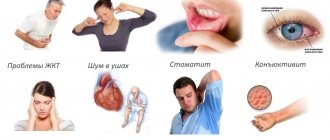Pharmacological properties
Piracetam belongs to the category of nootropic and psychostimulant drugs. The active component is considered a derivative of gamma-aminobutyric acid, which has a beneficial effect on the brain and improves its cognitive (cognitive) function. Systematic use of the drug allows you to increase learning ability, improve a person’s memory and increase his mental performance.
The mechanism of action of the drug is based on the acceleration of metabolic processes in brain cells: the rate of excitation increases, blood microcirculation is normalized. The drug is able to improve the rheological properties of blood. Piracetam affects synaptic conduction within the neocortical structures of the brain, improves communication between both hemispheres.
The medication is responsible for suppressing platelet aggregation, reducing red blood cell adhesion and increasing the elasticity of cell membranes. A solution injected into a vein (via a dropper) lowers fibrinogen levels. The maximum concentration of the active ingredient is observed in the blood plasma 30 minutes after the first administration. Piracetam is detected in the cerebrospinal fluid 6-8 hours after injection.
Does not bind to plasma proteins, bioavailability does not exceed 60-65%. It is not metabolized and is excreted unchanged from the body along with urine after glomerular filtration. Penetrates the blood-brain and placental barrier and is found in breast milk, lacrimal and cerebrospinal fluid.
Pharmacokinetics
The half-life of the drug from blood plasma is 4 - 5 hours and 8.5 hours from cerebrospinal fluid, which is prolonged in case of renal failure.
The pharmacokinetics of piracetam does not change in patients with liver failure.
Penetrates the blood-brain and placental barrier and membranes used in hemodialysis. In animal studies, piracetam selectively accumulates in the tissues of the cerebral cortex, mainly in the frontal, parietal and occipital lobes, in the cerebellum and basal ganglia. Does not bind to blood plasma proteins, is not metabolized in the body and is excreted unchanged by the kidneys. 80 - 100% of piracetam is excreted unchanged by the kidneys by renal filtration.
The renal clearance of piracetam in healthy volunteers is 86 ml/min.
Indications and contraindications for use
Adults are prescribed Piracetam for a number of pathologies. These include:
- chronic alcoholism;
- withdrawal symptoms;
- psychoorganic syndrome;
- balance problems (vertigo);
- vaso-occlusive crisis (including sickle cell disease);
- Alzheimer's disease;
- cortical myoclonus;
- brain injuries (including mechanical);
- coma states of various etiologies (toxic, vascular, traumatic);
- senile dementia (dementia) caused by impaired blood circulation.
The drug is prescribed to children for dyslexia and other learning disabilities. The use of the medication is strictly prohibited if the patient has absolute contraindications, which include:
- psychomotor overexcitement;
- children's age (up to 1 year);
- acute stage of stroke;
- period of pregnancy and lactation;
- severe renal failure;
- Huntington's chorea;
- individual intolerance to piracetam.
The medication has several relative contraindications. These include bleeding (history), kidney disease and hemostasis disorders.
Prescription during pregnancy and lactation
The period of bearing a child and breastfeeding is considered an absolute contraindication, therefore Piracetam is not prescribed to pregnant and lactating women.
Patients' opinions
The drug is widely used by students during sessions, exams and other mental stress, and when tired. People write that the medicine does not have the desired effect, and their health only gets worse.
Usually, after a course of injections, the effect is quickly consolidated and lasts about 3 months. At this time, migraines recede, dizziness does not occur, and there is no noise in the ears. Patients' sleep quickly normalizes and there is no lethargy or drowsiness.
But patients speak negatively about intramuscular administration. People often feel pain and burning at the puncture site. Lumps may form in the injection area. Before using piracetam, a person should consult a doctor to calculate the correct dosage and prescribe treatment. Some patients may be prescribed an effective analogue of piracetam in injections.
Piracetam in injections: instructions for use
A nootropic drug helps improve the functional activity of the brain only if all medical prescriptions are followed.
Dosage and course of treatment
The course of treatment in most cases is 10-14 days. The duration of therapy depends on the diagnosis. The initial daily dose is 400 mg (equivalent to 2 ml of solution). The therapeutic rate can be increased to 4000 mg (20 ml) with the permission of the doctor. Comatose conditions require administration of up to 12,000 mg of the drug per day to the patient. It is advisable to divide the dose into several doses (2 times or more). Drinking Piracetam in ampoules is not recommended.
How to administer piracetam intravenously?
At home, you can inject the drug into a vein; you cannot put in IVs (especially if you lack the necessary knowledge and experience). To avoid local reactions, you need to know how to properly inject into a vein. Algorithm:
- wash your hands with soap, put on gloves and wipe the injection site with alcohol;
- detect a visible, palpable vein;
- Apply a tourniquet to the arm bent at the elbow, just above the elbow;
- the patient must clench and unclench his fist several times;
- Draw the drug into a sterile syringe and release excess air;
- Using a needle directed perpendicular to the skin, carefully puncture the vein;
- remove the tourniquet;
- slowly introduce the solution;
- remove the needle, wipe the injection site with an alcohol wipe and bend your arm at the elbow.
When administered by drip, the drug is combined with saline solution.
Intramuscular injection
Intramuscular injections are carried out according to the standard scheme. The solution is drawn into a sterile syringe, the air is released and the drug is injected into the upper outer corner of the buttock. Press gently on the piston, the injection should last 60-80 seconds. After the needle has been removed, you need to wipe the skin with alcohol.
Side effects and overdose
Side effects occur if the individually selected treatment regimen is not followed. These include:
- thrombophlebitis;
- pain during injection (intravenously);
- confusion;
- fever;
- auditory and visual hallucinations;
- skin lesions (peeling, cracking);
- dermatitis;
- anxiety, irritability;
- epileptic seizures (rare);
- hives;
- ataxia;
- angioedema;
- loss of balance;
- skin itching;
- psycho-emotional overexcitation;
- allergic reactions (including anaphylactic shock);
- migraine, persistent headaches;
- rapid weight gain;
- uncontrollable vomiting;
- attacks of nausea;
- vertigo;
- defecation disorders (constipation, diarrhea);
- hypersensitivity reactions;
- sleep disorders (insomnia, drowsiness);
- problems with potency (in men);
- irritability;
- decreased blood pressure;
- motor activity disorders.
Side effects often go away on their own. An overdose that occurs when the daily norm is exceeded is accompanied by characteristic symptoms. These include:
- uncontrollable vomiting;
- loss of consciousness;
- dizziness;
- diarrhea with blood.
Emergency care includes gastric lavage and enterosorbents. If after the measures taken the patient’s condition has not improved, it is necessary to immediately take him to the nearest medical facility, where the doctor will prescribe symptomatic treatment after a detailed examination. There is no specific antidote.
Instructions
The medicine is prescribed in the form of injections to patients who suffer from severe chronic diseases, if the swallowing process is difficult or the person is in a coma. The drug is quickly absorbed into the blood and begins its action.
Treatment begins with 2–4 grams per day, gradually increasing it to 10–12 g. If the treatment is effective, then injections can be replaced with tablets. The medication can be administered intravenously through injections or droppers.
Intramuscular use of the drug is possible if it cannot be administered through a vein. But the drug can be administered intramuscularly no more than 5 ml. Injections into the muscle are painful for children and people who are underweight.
The daily dose of the drug for an adult is from 30 to 160 mg per kilogram of weight. If the patient's condition is very serious, then the dose per day can be about 12 grams. As you feel better, your doctor may prescribe piracetam tablets instead of injections.
To improve memory concentration, use from 2.4 to 4.8 grams per day. For strokes, the course of treatment is 14–28 days, 4.8 to 12 grams per day. After severe brain injuries or in coma, the doctor prescribes a dose of the drug from 9 to 12 g. After improvement, the dosage is reduced to 2 grams per day. Maintenance therapy lasts about three weeks.
Popular Is it worth installing an IV at home?
For alcohol syndrome, you can give injections of 12 grams per day. After achieving normal health, the drug is reduced to 2.4 g.
The dosage for a course of therapy for cortical myoclonus is prescribed from 7.2 grams, after which the dose is increased to 11.4 grams. The maximum dose for this disease reaches 24 grams. For patients with sickle cell anemia, the dosage reaches 160 ml per kilogram of weight. The dose is divided into 4 times.
special instructions
Before the injection, it is recommended to discontinue the evening medications previously prescribed to the patient. The medication affects platelet aggregation, so patients with bleeding and patients awaiting surgery require careful use of the drug, regardless of the form of release. In this case, it is better to start treatment with half doses.
People suffering from cortical myoclonus should not suddenly stop treatment: this will lead to a resumption of attacks. The drug must be taken systematically, otherwise the disease may worsen. Elderly patients are prescribed injections under the supervision of a physician, who is required to monitor blood pressure and indicators of liver and kidney function.
Combination of Piracetam injections with other medications
Piracetam is compatible with most medications. Disorientation, sleep disturbances, anxiety and irritability can be caused by the simultaneous use of a nootropic drug and medications that contain thyroid hormones. For patients suffering from venous thrombosis, it is not recommended to combine Piracetam with antibiotics due to the increased risk of changes in the rheological properties of the blood.
Central nervous system stimulants in combination with a nootropic can provoke psycho-emotional disorders. Extrapyramidal disorders are observed with the combined use of Piracetam and antipsychotics. Due to the fact that the active component is excreted from the body unchanged, the nootropic drug is not able to affect the bioavailability of other drugs.
The solution has positive compatibility with hydroxyethyl starch, mannitol, fructose, Ringer's solution, dextrose and sodium chloride.
Alcohol compatibility
The medication has negative compatibility with any drinks that contain ethanol. Patients are instructed to stop drinking alcohol 2-3 weeks before starting treatment with a nootropic drug.
Impact on the ability to drive vehicles and operate machinery
With long-term treatment of brain injuries with Piracetam, the risk of developing side effects, manifested in the form of clouding of consciousness, fainting and overexcitation, is quite high. Experts recommend refraining from driving a car or other vehicles.
Side effect
Side effects may occur during treatment with Piracetam:
- irritability;
- excitability;
- insomnia;
- dizziness;
- vomit;
- diarrhea;
- abdominal pain.
The medicine, even after a single dose, can cause exacerbation of coronary heart disease in older people. Side effects in children suffering from severe mental retardation include anxiety and motor activity. Often there is an attention disorder, the child becomes conflicted and irritable.
The drug affects the ability to drive.
Headaches and dizziness are considered to be common symptoms. Associated symptoms are clearly manifested in patients suffering from end-stage chronic renal failure, with a creatinine clearance of 20 ml/minute.
The drug has a negative effect on patients with cerebral hemorrhage. The drug in high doses can negatively affect a person’s health if he suffers from concomitant pathology or an individual reaction to the administration of the drug.
Analogues of the drug (briefly)
The drug has several analogues with similar therapeutic effects. Ingredients and price may vary. Generics include:
- Vinpocetine. The composition contains the substance of the same name. Release form: tablets and infusion solution. A medication that has a beneficial effect on the nervous system normalizes blood circulation in the brain. Price - from 50 rub.
- Cavinton. Contains vinpocetine, available in the form of solution and tablets. Improves brain metabolism and blood circulation. Cost - from 220 rubles.
- Pantogam. The active ingredient is hopantenic acid. It has several dosage forms (syrup and tablets). Stimulates brain activity and has virtually no contraindications.
Analogues are prescribed by a doctor. Independent choice of medication is strictly prohibited.
Interaction with other drugs
There was no interaction with clonazepam, phenytoin, phenobarbital, or sodium valproate.
High doses (9.6 g/day) of piracetam increased the effectiveness of acenocoumarol in patients with venous thrombosis: there was a greater decrease in platelet aggregation, fibrinogen levels, von Willebrand factor, blood and plasma viscosity than when acenocoumarol was prescribed alone.
The possibility of changing the pharmacodynamics of piracetam under the influence of other drugs is low, since 90% of the drug is excreted unchanged in the urine.
In vitro, piracetam does not inhibit cytochrome P450 isoforms CYP1A2, 2B6, 2C8, 2C9, 2C19, 2D6, 2E1 and 4 A9/11 at concentrations of 142, 426, and 1422 μg/ml. At a concentration of 1422 mcg/ml, a slight inhibition of CYP2A6 (21%) and ZA4/5 (11%) was noted. However, the Ki level of these two CYP isomers is sufficient when exceeding 1422 μg/ml. Therefore, metabolic interaction with other drugs is unlikely.
Moreover, piracetam at a dose of 20 mg/day did not change the peak and curve of the concentration level of antiepileptic drugs in the blood serum (carbamazepine, phenytoin, phenobarbital, valproate) in patients with epilepsy receiving a constant dosage.
Increases the effectiveness of antipsychotic drugs (neuroleptics).
When used concomitantly with drugs that stimulate the central nervous system, excessive stimulation of the central nervous system is possible.
When prescribed with antipsychotics, it reduces the risk of extrapyramidal disorders.
Overdose and drug interactions
If the permissible dosage of piracetam is exceeded, its side effects intensify. The drug can be combined with other medications, although it should be borne in mind that the effectiveness of some drugs is enhanced when taken this way. Because of this, it is recommended to first obtain the approval of the attending physician for such actions.
An overdose of the described drug can be determined by the signs that appear in the child after such use:
- anxiety;
- irritability;
- cry;
- sleep disturbance;
- loss of appetite;
- tremor of the limbs.
In such situations, it is necessary to immediately reduce the daily dose or completely abandon further therapy with this medication.
Features of application
Since the drug is excreted by the kidneys, patients with impaired kidney function should be careful. The dosage is reduced depending on the severity of the renal pathology. Constant monitoring of the condition of the kidneys is necessary. It is not recommended to abruptly discontinue the drug when treating cortical myoclonus. You must also remember that the speed of psychomotor reactions and attention may change, so you should be careful when driving a car. The instructions for Piracetam injections necessarily warn about this. Reviews note that this rarely happens; on the contrary, from the first day of treatment, mental and physical performance, attention and coordination of movements usually improve.
Indications
The use of the described notropic agent is indicated in the following situations:
- speech disorders;
- learning difficulties;
- impaired mental function;
- encephalitis of various forms;
- complex therapy of circulatory disorders in brain cells;
- traumatic brain injuries;
- cerebral palsy;
- autism;
- headache;
- balance disorders;
- Down syndrome;
- dizziness;
- comatose syndrome;
- cortical myoclonus;
- viral and bacterial infections of the central nervous system.
This drug is always prescribed only in complex therapy with the use of other medications. The course of treatment is very long - at least 3 weeks. Piracetam is also recommended for preventive purposes for schoolchildren before exams, at a time when their brain is constantly under high stress. The essence of such preventive measures when using this nootropic substance requires constant monitoring of the functioning of the cardiovascular system, kidneys and blood profile.
Intravenous injection
Let's start with intravenous infusion, since it is more preferable for a number of diseases such as myoclonus. Correctly injecting Piracetam should be done using a catheter, which is placed for a day, while the solution flows at a stable rate into the vein (if the patient is in a coma or suffers from a severe form of myoclonus).
To dilute the drug add:
- Hydroxyethyl starch;
- Mannitol;
- Dextrose;
- Sodium chloride;
- Fructose;
- Ringer.
The total concentration of the injection solution is calculated based on the patient’s health condition and therapeutic indications.
Piracetam should be injected into a vein (when treating, for example, vaso-occlusive crisis) for at least two minutes, and the daily dosage is distributed into several parts at equal intervals.
Intramuscular injection
Piracetam must be injected into the muscle:
- if it is difficult to insert it into a vein;
- when the patient is overexcited.
Although the concentration of the drug should be limited, especially if the patient is a child or has low body weight. In addition, due to the large amount of solution, pain may occur during intramuscular injections. But the solution injected into the muscle should not be more than 5 ml in volume . Piracetam should be taken in a reduced volume both orally and intravenously.
If possible, you can use the oral route of administration of the drug (this is indicated in the instructions for the therapeutic use of the oral drug).
The duration of therapy is determined by the doctor based on the nature of the disease and the severity of symptoms.





